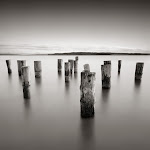On Coffee
When I first came to Russia in 1994, I was a confirmed coffee head. At that time, coffee meant Pele, a canned instant coffee that had the same relative components of coffee in the way Tang had the same relative components to orange juice. In other words, there were only vague similarities. It wasn't that the Russians didn't like coffee (that trend would come and go later on as a matter of principle as per the odd mechanisms of the Russian consumer mentality) but that they had just never had it. Most Russians first encounter with Pele happened in circumstances of dearth - at a kiosk in a railway station where there was no tea, at a friends house in the morning after a late night and so on. Pele was not hard to find in stores. I had it as a coffee substitute pretty regularly but without copious amounts of sugar and milk, often also difficult to marshal all at once at any given breakfast table, it was a last resort. I wasn't in any way against drinking tea and because everybody else did, tea became my drink of choice by default. I never really had coffee withdrawals. It was a smooth transition.
After coming from the Netherlands to live in Moscow permanently at the turn of the century, I had coffee in my blood. The Dutch do coffee well and I was a pot a day coffee head. In Moscow, corporate environments became my daily dwelling and I was pleasantly surprised that coffee - real coffee - was pretty much everywhere by that time. This is when I saw that Russians hated coffee. I had missed some kind of transition in the late 1990's when Pele had all but dissipated (its back now, by the way, with a marketing vengeance) and a plethora of instant and whole bean coffee was circulating in break rooms and offices all over. The instant coffee was better, but head and shoulders above the grey sand powder that came in metal tins in the early 1990's. Whole bean and ground coffee was available, but nobody knew how to make it. I witnessed many Russians make 'cowboy' coffee by putting expensive ground coffee in plastic cups with hot water. This didn't work and most thought it was crap because it was - when prepared like instant coffee.
The office I worked in had a drip coffee maker and whenever I started my day in our office instead of at a clients office I was the guy everybody asked to make coffee because I was the only one who could figure out how to replace yesterday's filter with a new one and brew fresh coffee. My colleagues often brewed several pots with a single filter, sometimes adding more grounds on top of the old ones. Cleaning the pot came as a revelation. Pretty soon all the guys drank coffee but the ladies were slow to adapt. I worked there for a few years and everybody got the hang of it more or less.
Making coffee at home has gone through several phases. I had a pot with a filter on top for a while and then several incarnations of an automatic drip coffee maker. I was the only coffee drinker at home so we got the small ones that only make a single cup or two cups maximum. This got ugly when guests came over - which was frequently and I eventually invested in a full on drip coffee maker with a big 6 cup pot. Almost immediately I dropped the pot and since then I have only used French press coffee makers. At first they were expensive, but now every hypermarket has several cheap-o variants to choose from and if you break it, which you will, replacing your French press doesn't' constitute a sacrificial offering. Now that my eldest daughter also needs coffee to function in the morning, our stand by French press is a large one that holds 4 whopping cups and is also suitable for having guests.
My work routine involves going to a local cafe to meet clients pretty regularly and as a cheap guy, I've moved from ordering cappuccinos to ordering double espressos. It started out as a more bang for the buck approach (the double espresso is cheaper than the cappuccino and only marginally more expensive than the Americano) but now I am simply a double espresso guy. I order it with a shot of hot milk on the side. I don't take sugar. My cafe is pretty decent and so shifting to double espresso was not a major ordeal. I am pretty much a regular coffee guy at home and a hard core coffee guy in town. Having reached this equilibrium, I also like to switch up brewing methods when I'm out and about.
A friend introduced me to Turkish coffee and I was mildly enthusiastic. I was not a big fan of the dregs. Over time, I have learned that 'Turkish' not a hard and fast term and that similar methods of preparation are popular all over Southern Russia where coffee has always been more of a staple alternative to tea, even in Soviet times. Georgian coffee is also prepared in a ibrik, but the method is different - sugar is put into the coffee before brewing and the shape and mouth of the pot are designed to keep the dregs in the pot and not deposit them in your cup. Georgian coffee is often prepared with cardamom or other spices and they don't freak out if you put milk in it.
I have been contemplating getting an ibrik pot for a while when a friend came to Russia after spending a prolonged tour in Italy. She arrived with a Bialetti 'brikka' coffee maker, a slightly modified version of the classic hexagonal shaped 1950's stove top espresso maker. She let me borrow it for a few days. Despite following the detailed instructions rather scrupulously, I couldn't manage to produce a cup of the famous 'crema' that the stove top coffee makers are famous for. I made several attempts, but as each experiment used the same amount of coffee I normally use for a full French press, my cheapness significantly hindered my learning curve. I managed to produce some dashing little cups of coffee that curdled the inner lining of my brain - this was also a factor in my limited ability to experiment - but I couldn't get the 'crema' to form. Besides, drinking a demitasse of rocket fuel coffee disrupted my more leisurely at home coffee routine. I like to drink coffee in the morning - several cups in fact - and I don't need my head to pop off like a champagne cork.
It was a good experiment, however, in that I have learned that I don't need espresso gear at home.
When I first came to Russia in 1994, I was a confirmed coffee head. At that time, coffee meant Pele, a canned instant coffee that had the same relative components of coffee in the way Tang had the same relative components to orange juice. In other words, there were only vague similarities. It wasn't that the Russians didn't like coffee (that trend would come and go later on as a matter of principle as per the odd mechanisms of the Russian consumer mentality) but that they had just never had it. Most Russians first encounter with Pele happened in circumstances of dearth - at a kiosk in a railway station where there was no tea, at a friends house in the morning after a late night and so on. Pele was not hard to find in stores. I had it as a coffee substitute pretty regularly but without copious amounts of sugar and milk, often also difficult to marshal all at once at any given breakfast table, it was a last resort. I wasn't in any way against drinking tea and because everybody else did, tea became my drink of choice by default. I never really had coffee withdrawals. It was a smooth transition.
After coming from the Netherlands to live in Moscow permanently at the turn of the century, I had coffee in my blood. The Dutch do coffee well and I was a pot a day coffee head. In Moscow, corporate environments became my daily dwelling and I was pleasantly surprised that coffee - real coffee - was pretty much everywhere by that time. This is when I saw that Russians hated coffee. I had missed some kind of transition in the late 1990's when Pele had all but dissipated (its back now, by the way, with a marketing vengeance) and a plethora of instant and whole bean coffee was circulating in break rooms and offices all over. The instant coffee was better, but head and shoulders above the grey sand powder that came in metal tins in the early 1990's. Whole bean and ground coffee was available, but nobody knew how to make it. I witnessed many Russians make 'cowboy' coffee by putting expensive ground coffee in plastic cups with hot water. This didn't work and most thought it was crap because it was - when prepared like instant coffee.
The office I worked in had a drip coffee maker and whenever I started my day in our office instead of at a clients office I was the guy everybody asked to make coffee because I was the only one who could figure out how to replace yesterday's filter with a new one and brew fresh coffee. My colleagues often brewed several pots with a single filter, sometimes adding more grounds on top of the old ones. Cleaning the pot came as a revelation. Pretty soon all the guys drank coffee but the ladies were slow to adapt. I worked there for a few years and everybody got the hang of it more or less.
Making coffee at home has gone through several phases. I had a pot with a filter on top for a while and then several incarnations of an automatic drip coffee maker. I was the only coffee drinker at home so we got the small ones that only make a single cup or two cups maximum. This got ugly when guests came over - which was frequently and I eventually invested in a full on drip coffee maker with a big 6 cup pot. Almost immediately I dropped the pot and since then I have only used French press coffee makers. At first they were expensive, but now every hypermarket has several cheap-o variants to choose from and if you break it, which you will, replacing your French press doesn't' constitute a sacrificial offering. Now that my eldest daughter also needs coffee to function in the morning, our stand by French press is a large one that holds 4 whopping cups and is also suitable for having guests.
My work routine involves going to a local cafe to meet clients pretty regularly and as a cheap guy, I've moved from ordering cappuccinos to ordering double espressos. It started out as a more bang for the buck approach (the double espresso is cheaper than the cappuccino and only marginally more expensive than the Americano) but now I am simply a double espresso guy. I order it with a shot of hot milk on the side. I don't take sugar. My cafe is pretty decent and so shifting to double espresso was not a major ordeal. I am pretty much a regular coffee guy at home and a hard core coffee guy in town. Having reached this equilibrium, I also like to switch up brewing methods when I'm out and about.
A friend introduced me to Turkish coffee and I was mildly enthusiastic. I was not a big fan of the dregs. Over time, I have learned that 'Turkish' not a hard and fast term and that similar methods of preparation are popular all over Southern Russia where coffee has always been more of a staple alternative to tea, even in Soviet times. Georgian coffee is also prepared in a ibrik, but the method is different - sugar is put into the coffee before brewing and the shape and mouth of the pot are designed to keep the dregs in the pot and not deposit them in your cup. Georgian coffee is often prepared with cardamom or other spices and they don't freak out if you put milk in it.
I have been contemplating getting an ibrik pot for a while when a friend came to Russia after spending a prolonged tour in Italy. She arrived with a Bialetti 'brikka' coffee maker, a slightly modified version of the classic hexagonal shaped 1950's stove top espresso maker. She let me borrow it for a few days. Despite following the detailed instructions rather scrupulously, I couldn't manage to produce a cup of the famous 'crema' that the stove top coffee makers are famous for. I made several attempts, but as each experiment used the same amount of coffee I normally use for a full French press, my cheapness significantly hindered my learning curve. I managed to produce some dashing little cups of coffee that curdled the inner lining of my brain - this was also a factor in my limited ability to experiment - but I couldn't get the 'crema' to form. Besides, drinking a demitasse of rocket fuel coffee disrupted my more leisurely at home coffee routine. I like to drink coffee in the morning - several cups in fact - and I don't need my head to pop off like a champagne cork.
It was a good experiment, however, in that I have learned that I don't need espresso gear at home.









No comments:
Post a Comment